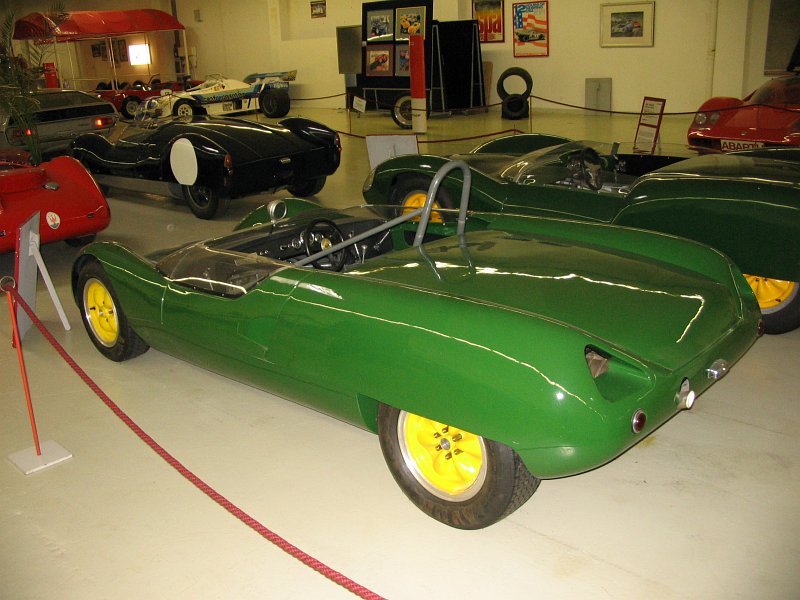Description
The Lotus 23B, introduced in 1963, was the definitive and most successful version of the legendary Lotus 23 sports-racing car. It represented the refinement of Colin Chapman’s original 23 design — a car that had already set new standards for lightness, agility, and aerodynamic efficiency — into an even faster, stronger, and more reliable competition machine. The 23B retained the same essential layout and dimensions as the original model but incorporated numerous improvements to the chassis, suspension, transmission, and engine options that made it more competitive in both national and international racing. It became one of the most widely raced and successful Lotus models of the 1960s, cementing the 23’s reputation as one of the greatest lightweight sports-racers ever built.
Like the original 23, the 23B was built around a tubular steel spaceframe chassis derived from Lotus’s single-seater Formula Junior cars. However, Chapman and his engineers made several key changes to increase strength and durability while maintaining the car’s exceptional lightness. The rear suspension was completely redesigned, replacing the earlier low-pivot arrangement with reversed lower wishbones, twin radius arms, and a top link to control camber more precisely and reduce flex under load. This modification greatly improved high-speed stability and cornering consistency, particularly on rough circuits. The front suspension also received revised geometry for sharper turn-in and reduced bump steer.
The chassis was clothed in the same low, aerodynamic fibreglass body designed by Ron Hickman, but the 23B sat slightly wider on its track to improve balance and grip. The body shape remained one of the most efficient of its era, with a low nose, curved fenders, and a cleanly cut tail that minimised drag while maximising airflow to the engine and brakes. The total weight of the car was around 455 kilograms, and despite its small size, it was structurally rigid and capable of handling much greater power than before.
Power for the 23B came from a range of engines depending on customer choice and racing class. The most common units were the 1.5-litre and 1.6-litre Lotus-Ford Twin Cam engines, developed from the Ford Kent block and tuned by Cosworth or Holbay to produce between 140 and 165 horsepower. Some cars were also fitted with Coventry Climax FWA or FWB engines, though the Ford units soon became the standard choice due to their flexibility, reliability, and abundant torque. Power was transmitted to the rear wheels through a new Hewland five-speed transaxle, replacing the Renault unit used in the original 23. The Hewland gearbox was stronger, smoother, and better suited to the car’s increasing power levels, allowing drivers to exploit the engine’s performance to the full.
The result was a car that was extraordinarily quick. With the 160-horsepower Lotus-Ford engine fitted, the 23B could reach 60 mph in under 4.5 seconds and exceed 150 mph on long straights. Yet its true brilliance lay not in outright speed, but in its agility, braking, and cornering balance. The 23B’s mid-engine layout and light weight gave it an unmatched ability to change direction and maintain high speeds through corners, while the four-wheel Girling disc brakes provided strong and reliable stopping power. The unassisted steering was light, direct, and communicative, allowing drivers to feel every nuance of grip and road texture.
The Lotus 23B made an immediate impact on the racing scene. It proved almost unbeatable in its class throughout the 1960s, dominating club and national championships across Britain, Europe, and the United States. In North America, the 23B became a legend in SCCA racing, where it regularly humbled much larger and more powerful cars, including Ferraris, Jaguars, and Corvettes. Drivers such as Jim Clark, Dan Gurney, and Frank Gardner achieved remarkable results with the 23B, while countless privateers found success in regional and endurance events. The car’s versatility and reliability made it a favourite among amateur racers, as it could be maintained with relative ease and adapted to different engines and circuits.
Visually, the 23B maintained the minimalist beauty of the original 23. Its proportions were perfect: low, compact, and purposeful. The simple one-piece fibreglass body opened forward for easy access to the chassis and mechanical components, and the cockpit was stripped of all but the essentials. A small steering wheel, a cluster of Smiths gauges, and a fixed racing seat were all the driver needed. Everything about the car reflected Chapman’s mantra: “Simplify, then add lightness.”
In competition, the 23B’s combination of speed, handling, and efficiency made it one of the most successful sports-racers of the decade. It continued to win well into the late 1960s, even as newer designs emerged, and many examples were later modified or restored for historic racing, where they remain extremely competitive to this day.
Only around 130 Lotus 23s were built in total, and a significant proportion were 23B specification. Their enduring popularity is a testament to their design brilliance — few cars have ever offered so much performance and precision in such a compact, elegant package.
Today, the Lotus 23B is revered as one of the finest lightweight racing cars ever made. It represents the perfection of the front-line Lotus philosophy: minimal mass, maximum efficiency, and unmatched driver involvement. In the 23B, Chapman and his team achieved a near-perfect balance between power, control, and aerodynamics — a car so pure in concept and execution that it remains, even six decades later, the benchmark for how a small, lightweight racing car should be built.




